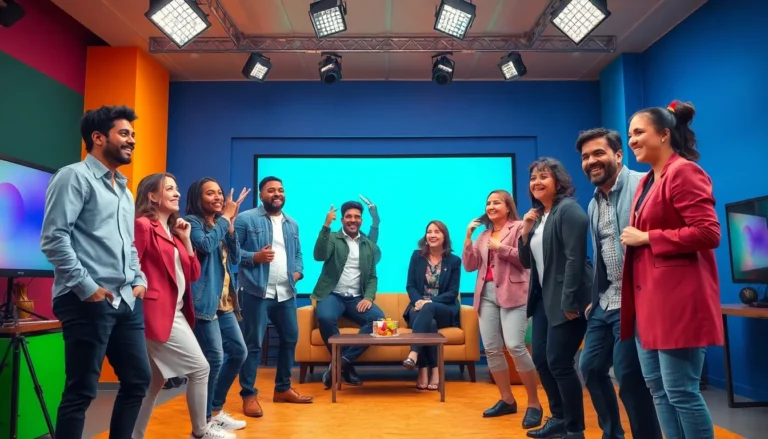Table of Contents
ToggleGen Z is shaking up the fashion world like a TikTok dance challenge gone viral. With their unique sense of style, this generation isn’t just following trends—they’re creating them. From thrifted finds to bold statement pieces, they’re redefining what it means to be fashionable in a way that makes even the most seasoned fashionistas raise an eyebrow.
Overview of Gen Z Trends Fashion
Generation Z significantly influences fashion trends through unique styles and individualized expressions. Thrift shopping has become a major practice, with many opting for second-hand clothes to promote sustainability. Fast fashion’s appeal diminishes as this generation prioritizes eco-friendly practices. Vintage items gain popularity, showcasing a mix of nostalgia and modernity in wardrobe choices.
Statement pieces frequently emerge as staples in Gen Z outfits. Bright colors, unexpected patterns, and bold accessories help them project confidence and creativity. Comfort remains essential, driving preferences for relaxed fits and versatile clothing options. This focus on comfort aligns with a broader shift toward casual wear in everyday life.
Online platforms amplify Gen Z’s impact on fashion. Social media channels, particularly TikTok and Instagram, serve as primary sources of inspiration for their trends. Influencers play a crucial role, with many collaborating with brands to launch exclusive collections. Viral challenges and trends introduce new styles rapidly, encouraging experimentation among peers.
Representation is important, leading to increased demand for inclusive sizing and gender-neutral fashion. Shunning the traditional binary, brands adapt to cater to multiple identities and body types. The authentic expression of self has never been more valued, reshaping industry standards.
Brands that understand these nuances thrive in capturing Gen Z’s attention. Marketing strategies reflect transparency and social consciousness, aligning with the values this generation upholds. Collaborative efforts with young designers and creators further engage this demographic. Authenticity and relatability resonate deeply, making it essential for brands to connect meaningfully.
The landscape of fashion continues to evolve, driven by the creativity and values of Generation Z.
Key Influencers of Gen Z Fashion
Generation Z’s approach to fashion deeply intertwines with various influencers, shaping trends and encouraging individual expression.
Social Media Impact
Social media significantly alters how Gen Z engages with fashion. Platforms like TikTok and Instagram serve as breeding grounds for trends, where viral challenges and style inspiration flourish. Creators showcase unique outfits that resonate with their followers, leading to widespread adoption of new styles. High engagement rates on these platforms accelerate trend cycles, driving rapid shifts in fashion preferences. Trendsetters share their thrift finds and styling tips, reinforcing sustainable practices while appealing to Gen Z’s desire for originality. Trend-savvy users rapidly embrace and adapt styles, creating a dynamic loop of influence and feedback.
Celebrity Endorsements
Celebrity endorsements also play a pivotal role in shaping Gen Z’s fashion landscape. Influential figures, from singers to actors, launch collections that reflect current cultural shifts and preferences. Young consumers often look to these celebrities for fashion guidance, seeking products associated with their favorite stars. Collaborations between celebs and brands amplify visibility, creating buzz and urgency around new releases. Notable examples include high-profile partnerships that balance luxury with accessibility, making fashion more appealing to Gen Z. The authenticity of these endorsements fosters a strong connection, driving engagement and loyalty among youthful audiences.
Popular Styles Among Gen Z
Generation Z embraces various fashion styles that reflect their values and individuality. Their choices challenge traditional trends and highlight a distinct cultural identity.
Streetwear Essentials
Streetwear defines a significant part of Gen Z’s wardrobe. Hoodies, oversized tees, and joggers represent comfort while showcasing personal style. Sneakers, especially limited-edition releases, remain a top choice for footwear. Caps and bucket hats add an urban twist, enhancing outfits with sleek accessories. Layering allows creativity, letting individuals mix and match styles and textures effortlessly. Graphic designs often convey messages, making statements through fashion. The blend of high-end collabs with casual items signals a fresh approach to mainstream looks.
Sustainable Fashion Choices
Sustainability stands at the forefront of Gen Z’s fashion decisions. Thrift shopping encourages eco-friendly practices as they seek unique second-hand pieces. Vintage finds allow for individuality while promoting a circular economy. Brands prioritizing sustainable materials resonate deeply with this generation. Organic cotton, recycled fabrics, and ethical manufacturing methods capture attention. Awareness of fast fashion’s impact has prompted many to choose quality over quantity. Investing in timeless pieces reflects a growing commitment to responsible consumption, aligning perfectly with their values.
The Role of Vintage and Thrift Fashion
Vintage and thrift fashion plays a significant role in Generation Z’s approach to style. This demographic actively embraces second-hand clothing as a way to promote sustainability and counteract the rapid consumption associated with fast fashion. Many individuals within this generation prefer unique pieces with a history, aligning their wardrobe choices with eco-conscious values.
The popularity of thrift shopping continues to rise, with thrift stores and online platforms becoming prominent sources for fashionable finds. Vintage clothing not only creates a sense of nostalgia but also allows for creative self-expression, as it often features designs not found in mainstream retail. Unique styles sourced from past eras enable Gen Z to stand out, reinforcing their commitment to individuality.
Social media platforms amplify these trends, with users sharing their latest thrift hauls and styling tips. Instagram and TikTok serve as inspiration hubs where influencers showcase how vintage items can be integrated into modern wardrobes. Engaging visuals and relatable content encourage more young consumers to explore thrift options instead of opting for conventional retail outlets.
Sustainability extends beyond clothing choice, influencing shopping habits toward eco-friendly brands. Generation Z often researches brands that prioritize ethical production and responsible sourcing. This shift encourages retailers to adapt their practices to meet consumer demands, further solidifying the connection between thrift fashion and environmental consciousness.
Vintage and thrift fashion serves as a beacon for creativity and sustainability among Generation Z. Their unique styles reflect broader cultural movements, shaping how fashion is perceived and consumed today. Rising engagement with sustainability indicates a transformative shift in the fashion industry, driven heavily by the preferences of this generation.
Generation Z is reshaping the fashion landscape in ways that reflect their values and individuality. Their embrace of thrift and vintage fashion not only promotes sustainability but also fosters a unique style that stands apart from mainstream trends.
As they continue to influence the industry through social media and collaborations with brands, the demand for inclusivity and authenticity grows stronger. This generation’s commitment to responsible consumption and personal expression is paving the way for a more diverse and innovative fashion future, making it clear that their impact will be felt for years to come.





